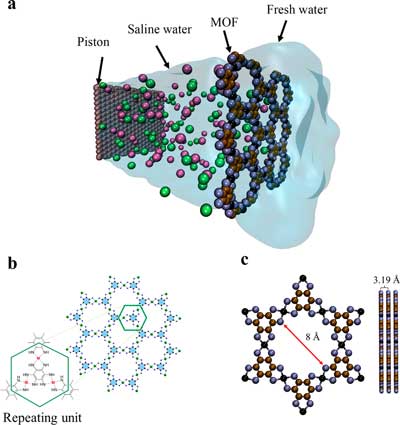| Dec 11, 2019 | |
Metal-organic frameworks as high-performance water desalination membranes |
|
| (Nanowerk Spotlight) Reverse osmosis (RO) is one of the most effective desalination technologies for producing freshwater from seawater. An osmotic process is a natural phenomenon that is driven by an osmotic pressure gradient across a partially permeable membrane. Water diffuses naturally through the membrane, leaving behind all impurities. | |
| The reverse osmosis membrane water reclamation process is very energy intensive – not exactly an advantage given the rising cost of energy and the negative climate impact of fossil fuels. | |
| In addition, the traditionally used RO membranes are causing slow water transport, which has led researchers to experiment with two-dimensional (2D) nanomaterials such as graphene or MoS2 to fabricated novel desalination membranes (read more: "Desalination with nanoporous graphene membrane" and "2D nanomaterial reverse osmosis membrane for water desalination"). | |
| Another group of materials with angstrom-size intrinsic porosity are metal-organic frameworks (MOFs). However, given the large number of MOFs that have been fabricated and characterized – over 20 000 – the challenge is to identify suitable candidates for the fabrication of efficient RO membranes. | |
| "Using molecular dynamic simulation, we investigated the permeation coefficient and ion rejection rate of nanoporous MOF as a function of external hydrostatic pressure, lateral and orthogonal water diffusion, density and velocity of water at the pore, effect of MOF metal element, and number of MOF layers," Amir Barati Farimani, an Assistant Professor of Mechanical Engineering, Machine Learning, Chemical Engineering and Biomedical Engineering at Carnegie Mellon University, tells Nanowerk. "The phenomenon we observed is that MOF allows higher water flux compared to other 2D materials while rejecting almost 100% of unwanted ions." | |
 |
|
| (a) Schematic of a typical simulation box consists of a graphene piston, saline water with potassium and chloride ions, membrane (MOF, graphene/MoS2), and fresh water section. (b) Chemical structure of HAB-derived 2D MOFs. In our simulations, M is nickel or copper atoms. (c) Detailed view of a repeating unit of Ni/Cu-HAB MOF. The pore diameter is measured to be approximately 8 Å. For multiple layers membranes, the distance between each layer is 3.19 Å, and all layers are fully aligned. (Reprinted with permission by American Chemical Society) | |
| Farimani and his team reported their findings in Nano Letters ("Water Desalination with Two-Dimensional Metal-Organic Framework Membranes") | |
| After further investigating the water density and trajectories around the MOF, the researchers found that the potential wells on both sides of the MOF can be weaker than those of other materials, which allows water molecules to pass through MOF pores with less energy required. | |
| "Our work advanced the field not only by proposing that 2D MOFs can be a great material for water desalination but also by providing an answer to why 2D MOFs can outperform other membrane materials," Farimani points out. | |
| There are two innovative points raised by this work. One is the possibility of using two-dimensional MOFs – more specifically conductive metal hexaaminobenzene (M-HAB) – in water desalination. The other is the importance of a material's intrinsic porosity for water desalination. | |
| In water desalination, the two most importance factors that determine a membrane material's performance are its abilities to reject ions and to allow high water flux to pass through. The former is determined by the size of nanopores of the material and the latter is determined by its porosity. | |
| "The M-HAB MOF investigated in our work has a perfect pore size (8 Å diameter) and intrinsic porosity," notes Farimani. "The use of this membrane material in reverse osmosis will allow to generate fresh water with significantly lower cost." | |
| The team's simulations showed the outstanding performance of this MOF with a peak water permeation rate of about 1 order of magnitude higher than graphene/MoS2 membranes. Moreover, the MOF has 3-6 orders of magnitude higher water permeation rate compared to commercially used membranes (MFI-type zeolite, commercial polymeric seawater RO, brackish RO, nanofiltration, and high-flux RO). | |
| "Seeing the huge reduction in energy consumption of this particular MOF RO membrane, our work will hopefully stimulate other researchers? interest in experimentally applying different kinds of MOFs in the field of water desalination, " Farimani concludes. "However, although MOFs are very intriguing materials for desalination or ion/gas separation, the fabrication of large scale, few layers MOFs will remain a major challenge for mass production of these membranes." | |
 By
Michael
Berger
– Michael is author of three books by the Royal Society of Chemistry:
Nano-Society: Pushing the Boundaries of Technology,
Nanotechnology: The Future is Tiny, and
Nanoengineering: The Skills and Tools Making Technology Invisible
Copyright ©
Nanowerk LLC
By
Michael
Berger
– Michael is author of three books by the Royal Society of Chemistry:
Nano-Society: Pushing the Boundaries of Technology,
Nanotechnology: The Future is Tiny, and
Nanoengineering: The Skills and Tools Making Technology Invisible
Copyright ©
Nanowerk LLC
|
|
|
Become a Spotlight guest author! Join our large and growing group of guest contributors. Have you just published a scientific paper or have other exciting developments to share with the nanotechnology community? Here is how to publish on nanowerk.com. |
|
